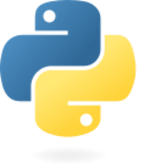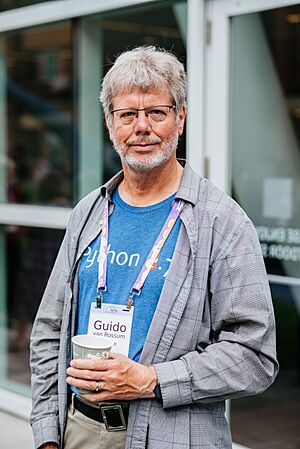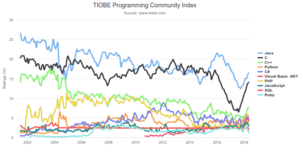Python (programming language) facts for kids
 |
|
| Paradigm | Multi-paradigm: object-oriented, procedural (imperative), functional, structured, reflective |
|---|---|
| Designed by | Guido van Rossum |
| Developer | Python Software Foundation |
| First appeared | 20 February 1991 |
| Stable release | |
| Preview release |
3.14.0rc1 / 22 July 2025
|
| Typing discipline | duck, dynamic, strong; optional type annotations |
| OS | Cross-platform |
| License | Python Software Foundation License |
| Filename extensions | .py, .pyw, .pyz, .pyi, .pyc, .pyd |
| Major implementations | |
| CPython, PyPy, MicroPython, CircuitPython, IronPython, Jython, Stackless Python | |
| Dialects | |
| Cython, RPython, Starlark | |
| Influenced by | |
| ABC, Ada, ALGOL 68, APL, C, C++, CLU, Dylan, Haskell, Icon, Lisp, Modula-3, Perl, Standard ML |
|
| Influenced | |
| Apache Groovy, Boo, Cobra, CoffeeScript, D, F#, GDScript, Go, JavaScript, Julia, Mojo, Nim, Ring, Ruby, Swift, V | |
|
|
|
Python is a very popular and easy-to-learn programming language. It's used for many different things, like building websites, creating games, and even helping with artificial intelligence.
One of the best things about Python is how easy its code is to read. It uses special spacing to organize code, which makes it look neat and tidy. Python is also very flexible and can be used in many different ways to solve problems.
Python was created by Guido van Rossum in the early 1990s. Since then, it has grown a lot and is now one of the most widely used programming languages in the world. Many schools and universities teach Python as a first programming language because it's so beginner-friendly.
Contents
The Story of Python
Python was first thought up by Guido van Rossum in the late 1980s. He was working in the Netherlands and wanted to create a new language. He started building Python in December 1989.
Guido was the main person in charge of Python's development for a long time. People in the Python community even called him the "benevolent dictator for life" (BDFL). This showed how much they trusted him to make big decisions for the language. In 2018, he decided to take a break, but he still helps out sometimes. Now, a group of five core developers leads the project.
The name Python comes from the British comedy show Monty Python's Flying Circus. Guido van Rossum was a big fan of the show!
Python has had a few big updates over the years. Python 2.0 came out in 2000, adding cool new features like ways to create lists more easily. Python 3.0 was released in 2008. This was a major change, and some older Python 2 code didn't work with it. The last version of Python 2 was released in 2020.
As of August 2025, Python 3.13 is the newest stable version. Python versions get updates and security fixes for several years after they are released.
How Python Works and What It Can Do
Python is a very flexible language. This means you can use it for different styles of programming, like:
- Object-oriented programming: Thinking about code as collections of "objects" that have properties and can do actions.
- Structured programming: Organizing code in a clear, step-by-step way.
- Functional programming: Using functions to build your programs.
Python is often called a 'glue language'. This is because it can easily connect different parts of a program, even if those parts were written in other programming languages.
Python automatically manages computer memory. It also checks for errors in your code as it runs, which helps catch mistakes.
Python's main ideas are summed up in something called the Zen of Python. Some of these ideas are:
- Beautiful code is better than messy code.
- Clear code is better than hidden code.
- Simple code is better than complicated code.
- Code that is easy to read is very important.
Python is designed to be simple at its core, but it can be made more powerful with "modules." These are like add-on tools that you can use. This idea came from Guido van Rossum's experience with an older language called ABC. He wanted Python to be easy to expand.
Unlike some other languages that say "there's more than one way to do it," Python tries to have "one—and preferably only one—obvious way to do it." This helps keep code consistent and easy to understand.
Python's creators also want the language to be fun to use! That's why it's named after Monty Python, and why you'll often see funny words like "spam" and "eggs" in code examples instead of "foo" and "bar." When something is done in a "Pythonic" way, it means it follows Python's style and is easy to read.
Python's Code Rules
Python is designed to be easy to read. It uses English words for many commands instead of confusing symbols. Unlike many other languages, it doesn't use curly brackets `{}` to group code. Instead, it uses special spacing.
Using Indentation
Python uses spaces at the beginning of lines to show how code is grouped. When you indent (add spaces), it means you're starting a new block of code. When you unindent (remove spaces), it means that block is ending. This makes the code's structure very clear just by looking at it. The usual recommendation is to use four spaces for each indent.
Basic Commands and Flow
Python has many commands, called "statements," that tell the computer what to do:
- `=` is used to give a name to a value, like `score = 100`.
- `if`, `else`, and `elif` help your program make decisions.
- `for` and `while` are used to repeat actions.
- `try` and `except` help handle errors that might happen.
- `class` helps you create your own types of objects.
- `def` is used to create functions, which are blocks of code that do a specific task.
- `break` stops a loop, and `continue` skips to the next part of a loop.
- `import` helps you use code from other files or "modules."
Python variables don't have a fixed "type" like in some other languages. A variable can hold a number, then later hold text. This is called "dynamic typing."
Expressions and Calculations
Python can do math just like a calculator:
- `+`, `-`, `*` are for adding, subtracting, and multiplying.
- `/` is for regular division (giving you a decimal answer).
- `//` is for "floor division" (giving you a whole number answer, like 5 // 2 equals 2).
- `**` is for powers, like `5**3` (5 to the power of 3, which is 125).
Python also uses `+` to join text together, like `"hello" + "world"` becomes `"helloworld"`.
You can compare things using `==` (is equal to), `<` (less than), `>` (greater than), and so on. You can even chain comparisons, like `a < b < c`.
Python has special ways to create lists and other collections of data.
- Lists are written with square brackets, like `[1, 2, 3]`. You can change lists after you create them.
- Tuples are written with parentheses, like `(1, 2, 3)`. You cannot change tuples after you create them.
Python also has different ways to write text, called "strings":
- You can use single quotes (`'hello'`) or double quotes (`"world"`).
- You can use three quotes (`"""This can span multiple lines"""`) for longer text.
- If you put an `r` before the quotes (`r"C:\new\folder"`), it's a "raw string" that treats backslashes normally.
Functions in Python
You create functions in Python using the `def` keyword. Functions are like mini-programs that you can call whenever you need them.
def say_hello(name):
print("Hello, " + name + "!")
say_hello("Alice")
# Example output:
# Hello, Alice!You can also give functions default values for their inputs, so they still work even if you don't provide every piece of information.
Example Code
Here's a classic "Hello, World!" program in Python:
print('Hello, world!')This program calculates the factorial of a positive number (like 5! = 5 * 4 * 3 * 2 * 1):
n = int(input('Type a number, and its factorial will be printed: '))
if n < 0:
raise ValueError('You must enter a non-negative integer')
factorial = 1
for i in range(2, n + 1):
factorial *= i
print(factorial)Python's Big Toolbox (Libraries)
One of Python's biggest strengths is its huge "standard library." This is like a giant toolbox filled with ready-made code that you can use. It has tools for:
- Working with the internet (like websites).
- Creating graphical user interfaces (GUIs), which are the visual parts of programs you click on.
- Connecting to databases.
- Making random numbers.
- Testing your code to make sure it works.
Beyond the standard library, there's also the Python Package Index (PyPI). This is a huge online storehouse of even more Python tools created by other people. As of March 2025, there are over 614,339 packages! These packages can help you with:
- Automation (making things happen automatically)
- Data analytics (understanding data)
- Databases (storing information)
- Graphical user interfaces (making apps look good)
- Image processing (editing pictures)
- Machine learning (teaching computers to learn)
- Computer networking (connecting computers)
- Scientific computing (using computers for science)
- Web frameworks (building websites)
- Web scraping (collecting info from websites)
Where You Can Code Python
Most Python versions come with a simple tool called a read–eval–print loop (REPL). It lets you type Python commands one by one and see the results right away. This is great for trying out small pieces of code.
Python also comes with a basic program called IDLE, which is a simple IDE. An IDE is a special program that helps you write, test, and fix your code.
Many other powerful IDEs are available, like PyCharm and Visual Studio Code. There are also online IDEs that you can use right in your web browser, like Jupyter Notebooks and PythonAnywhere. These are great for learning and sharing your code.
Different Ways Python Runs
The main way Python runs is through something called CPython. This is the original and most common version of Python. It takes your Python code and turns it into a special "bytecode" that the computer can understand and run. CPython works on many different computer systems, like Windows, macOS, and Linux.
There are also other versions of Python, called "implementations," that work a bit differently:
- PyPy is a faster version of Python that uses a special technique called "just-in-time compilation" to make programs run quicker.
- MicroPython and CircuitPython are tiny versions of Python made for small computers called microcontrollers, which are found in things like robots or smart devices.
Some tools can even turn Python code into other programming languages, like C or JavaScript. This can sometimes make Python programs run even faster or work in new places, like web browsers.
How Python Grows and Changes
Python's development is guided by something called the Python Enhancement Proposal (PEP) process. This is how new ideas and changes to the language are suggested, discussed, and decided upon by the Python community. For example, PEP 8 gives guidelines on how to write Python code so it's easy to read.
New versions of Python are released regularly.
- Major updates (like Python 3.9 to 3.10) happen about once a year and add new features.
- Bug fix updates (like Python 3.10.1 to 3.10.2) happen every few months to fix problems and security issues.
There's a big meeting called PyCon where Python developers and users from all over the world come together to share ideas and learn. There are also groups like PyLadies that help mentor new Python programmers.
Why Python is So Popular
Python has been one of the most popular programming languages for many years. It's often ranked as the number one language in surveys like the TIOBE Index. This index looks at how often programming languages are searched for online. Python has been named "Programming Language of the Year" four times!
Python's popularity comes from its easy-to-read code, its huge collection of tools (libraries), and its wide use in exciting fields like machine learning and data science.
Many big companies and organizations use Python, including Wikipedia, Google, NASA, Facebook, Amazon, Instagram, and Spotify. The social media site Reddit was also built mostly with Python.
What Python is Used For
Python is used for many different things:
- Building web applications (the software that runs websites).
- Doing scientific computing and research.
- Creating artificial intelligence and machine learning projects.
- Making graphical user interfaces (GUIs) for desktop programs.
- Adding scripting to other software and even hardware.
- Helping with information security.
For websites, Python has many "web frameworks" like Django and Flask. These frameworks make it easier to design and manage complex websites.
In science, libraries like NumPy and SciPy help scientists work with numbers and data. Python is also very important for AI and machine learning, with libraries like TensorFlow and PyTorch.
Python is often built into other software programs as a way to add custom features. For example, 3D animation programs like Blender and Maya use Python for scripting. The Raspberry Pi computer also uses Python as its main programming language for users.
Many computer operating systems, especially Linux distributions, include Python as a standard part. Some Linux installers are even written in Python!
Languages Inspired by Python
Python's design has influenced many other programming languages. For example:
- CoffeeScript and Nim use similar indentation rules.
- JavaScript borrowed ideas like "iterators" and "generators" from Python.
- Go and Julia were designed to be as easy to use as Python.
- Ruby's creator wanted a language that was more object-oriented than Python.
- Swift, a language from Apple, also has some Python-like features.
Python's way of proposing changes, through the "Python Enhancement Proposal" (PEP) document, has also been copied by other languages like Tcl and Swift.
See also
 In Spanish: Python para niños
In Spanish: Python para niños
- Python syntax and semantics
- pip (package manager)
- List of programming languages
- History of programming languages
- Comparison of programming languages



